alongside Chirality & Symmetry
page 3
| 1 | 2 | 3 | 4 | 5 | 6 | 7 | 8 |
Experimental Thinkers as of 3-27-2023
Again, (imaginatively speaking from another analogical perspective) if we view the macromolecules as a civilization of little people who initially practiced a free-for-all type of clannish culturalization (let us say some early model of Nature-based Polytheism) and then developed the practice of worshipping a triune god that we call a triplet code; what we have is the presence of a pattern being played out by humans in their variations of ideological orientation. Yes I realize the analogy is not a conventional one, however, the very idea that life may have originated in a little pond was a radical view in its day when it was proposed by Darwin and then later followed up by Oparin.
Aleksandr Oparin: Russian biochemist noted for his studies on the origin of life from chemical matter. By drawing on the insights of chemistry, he extended the Darwinian theory of evolution backward in time to explain how simple organic and inorganic materials might have combined into complex organic compounds and how the latter might have formed the primordial organism.
When Oparin was nine, his family moved to Moscow because there was no secondary school in their village. While majoring in plant physiology at Moscow State University, Oparin was influenced by K.A. Timiryazev, a Russian plant physiologist, who had known the English naturalist Charles Darwin. The indirect effect of Darwin upon Oparin's thinking can be found in many of the latter's writings.
At a meeting of the Russian Botanical Society in the spring of 1922, Oparin first introduced his concept of a primordial organism arising in a brew of already formed organic compounds. He stated a number of premises that were not popular at the time. For example, according to his hypothesis, the earliest organisms were heterotrophic; i.e., they obtained their nutrition ready-made from compounds that had already been formed in variety and profusion by what are in the laboratory quite ordinary means. Thus, at that early stage, these first organisms did not need to synthesize their own food materials in the way that present-day plants do. Oparin also emphasized that a high degree of structural and functional organization is characteristic of the living state, a point of view that is in opposition to the idea that “life” is essentially molecular. He was also farsighted in his observation that living organisms, as open systems, must receive energy and materials from outside themselves; they cannot, therefore, be limited by the second law of thermodynamics, which is applicable to closed systems in which energy is not replenished.
When Oparin first proposed his hypothesis, the prevailing view was that the first organisms could make all of their own organic compounds, and so the negative reaction to his proposal was almost universal. With continued retesting, however, his concept has come to be accepted in its main outlines. Although the possibility of a natural origin of life had been promulgated for at least 2,500 years, a specific formulation had to compete with vitalistic points of view in modern times. Also, organic chemistry, necessary for Oparin's hypothesis, had not been sufficiently developed by the time of the 19th-century French pathologist Louis Pasteur. ("Oparin, Aleksandr." Encyclopædia Britannica, 2013.)
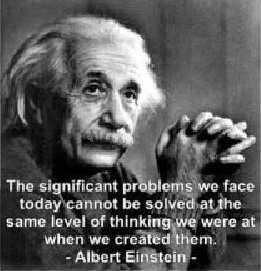
Different ways of thinking have got to be applied to the concept of life's genesis because current models aren't working. Analogies and concepts from different subjects are already being used as an accepted methodology of research in other fields. We must view our questions as having created a problem that require a different model of thinking in order to solve it... as is the quote attributed to Einstein.
By looking at recurring patterns that we see in human behavior and considering them to be later-born... if not evolved variations of patterns from more basic biological dimensions of activity, then looking at recurring patterns that humans engage in might be instructive in our quest to define the parameters in which life sprouted, noting that in several instances we create miniaturizations such as in the case of creating toys for children which resemble adult products. Like humans having practiced a one-field system before switching to a three-field system of growing crops, let us place this same pattern as an occurrence which took place with respect to the development of life. Hence, we can see a recurrence of different situations in which a "3" is preceded by a "2", though the presence of a "1" may only be visible since a secondary position has either been wholly by-passed or has become so disused as to be negligibly visible in the same manner as we do when observing the "1" and "3". And like the use of a trisomy model of genetics for grain crops; life too used this same methodology billions of years ago. Like a long-distance mirror-image, where the tripartite structure of human anatomy can be described as a child who is a chip off the old block, or otherwise noted as an apple related to a particular tree.
Open-field system
The precise origin of the open-field arrangement, which involves long strips of arable land separated from each other by a furrow, balk (ridge of land left after plowing), or mere (boundary), is obscure. The earliest examples of this system date from roughly 800, the year Charlemagne was crowned emperor of the West. Usually these strips of land, normally about 1 acre (0.4 hectare) in size, were laid out in two or three large fields. Each farmer in the village worked a number of these acres; the units forming his holding were scattered among those of other men. The open-field system continued as more land was reclaimed and lasted for many centuries—longer, of course, in some places than in others. It has been suggested that the length of each strip was determined by the distance a draft animal, usually an ox, could haul a plow before stopping for a rest. The intermingling of the strips was said to have been the result of a jointly owned plow team and plow supplied by a number of farmers working together, each being allotted a strip in turn. A subsequent theory holds that in some places the division of fields, which may have originally been rectangular or square, among a number of heirs led to the creation of long, narrow acres. In theory each person's holding totaled 30 acres (12 hectares), comprising strips equally divided between the three arable fields. With the passage of time, wide variations in the size of holdings came about; many became very small. ("agriculture, origins of." Encyclopædia Britannica, 2013.)
Early experiments, such as those at the Rothamsted experimental station in England in the mid-19th century, pointed to the usefulness of selecting rotation crops from three classifications: cultivated row, close-growing grains, and sod-forming, or rest, crops. Such a classification provides a ratio basis for balancing crops in the interest of continuing soil protection and production economy. It is sufficiently flexible for adjusting crops to many situations, for making changes when needed, and for including go-between crops as cover and green manures.
A simple rotation would be one crop from each group with a 1:1:1 ratio. The first number in a rotation ratio refers to cultivated row crops, the second to close-growing grains, and the third to sod-forming, or rest, crops. Such a ratio signifies the need for three fields and three years to produce each crop annually. This requirement would be satisfied with a rotation of corn, oats, and clover or of potatoes, wheat, and clover-timothy. Rotations for any number of fields and crop relationships can be described in this manner. In general, most rotations are confined to time limits of eight years or less. ("crop rotation." EncyclopKædia Britannica, 2013.)
The use of manure and composts as fertilizers is probably almost as old as agriculture. Modern chemical fertilizers include one or more of the three elements that are most important in plant nutrition: nitrogen, phosphorus, and potassium. Of secondary importance are the (3) elements sulfur, magnesium, and calcium.
The more soluble superphosphate and triple superphosphate preparations are obtained by the treatment of calcium phosphate with sulfuric and phosphoric acid, respectively. Potassium fertilizers, namely potassium chloride and potassium sulfate, are mined from potash deposits. Mixed fertilizers contain more than one of the three major nutrients—nitrogen, phosphorus, and potassium. Mixed fertilizers can be formulated in hundreds of ways. ("fertilizer." Encyclopædia Britannica, 2013.)
Manure: Organic material that is used to fertilize land, usually consisting of the feces and urine of domestic livestock, with or without accompanying litter such as straw, hay, or bedding. Farm animals void most of the nitrogen, phosphorus, and potassium that is present in the food they eat, and this constitutes an enormous fertility resource. In some countries, human excrement is also used. Livestock manure is less rich in nitrogen, phosphorus, and potash than synthetic fertilizers and hence must be applied in much greater quantities than the latter. A ton of manure from cattle, hogs, or horses usually contains only 10 pounds of nitrogen, 5 pounds of phosphorus pentoxide, and 10 pounds of potash. But manure is rich in organic matter, or humus, and thus improves the soil's capacity to absorb and store water, thus preventing erosion. ("manure." Encyclopædia Britannica, 2013.)
I want to emphasize the "3" pattern because so very often it is the "2" pattern which is focused on and becomes used. The "3" is too often related to some religious or non-science orientation and application. However, if we can rely on those views in which the "3-pattern" such as the triplet code does arise is accurate and not some sort of ideological mimicry, then a suggestion involving a recognition of recurring cognitive patterns as a research tool will be a viable asset, if for nothing else than a trial and error approach. For example, if a "1" doesn't work then we need to try a "2", and/or a "3"... etc... For example, if a problem can be looked at as a type of lock for which we are hunting the key or combination to (though history provides examples where humans have and still do use voice, repetition, and sacrificial approaches); a given problem may require the used of three values or three keys turned simultaneously, like the motion picture representations of the use of two keys turned simultaneously to unlock a nuclear warhead usage.
It should not be surprising if we were to find that an active ingredient in the development of life required a given proportion of sound (vibration) that was present billions of years ago, much in the manner as some engage in the usage of a mantra to evoke some higher state of emergence in consciousness. No less, we find that photosynthesis has a particular range of "vocalization" within the color spectrum, as do all sound emitting life forms have their own respective (conserved) values of expression. Similarly, in the present discussion, the arrival of life is the emergent "consciousness" (viewed as a spectrum)... or at least the emergence of a path along which consciousness will be achieved in some manner by way of humanity, if not all life in its variations. While some scientists do not like to get into the usage of discursive materials involving (a wide latitude called) metaphysics, others are not particularly troubled by such considerations though they are not involved in chemical evolution experiments, just those experiments involving what they believe to be essential elements needed for achieving some higher state of being.
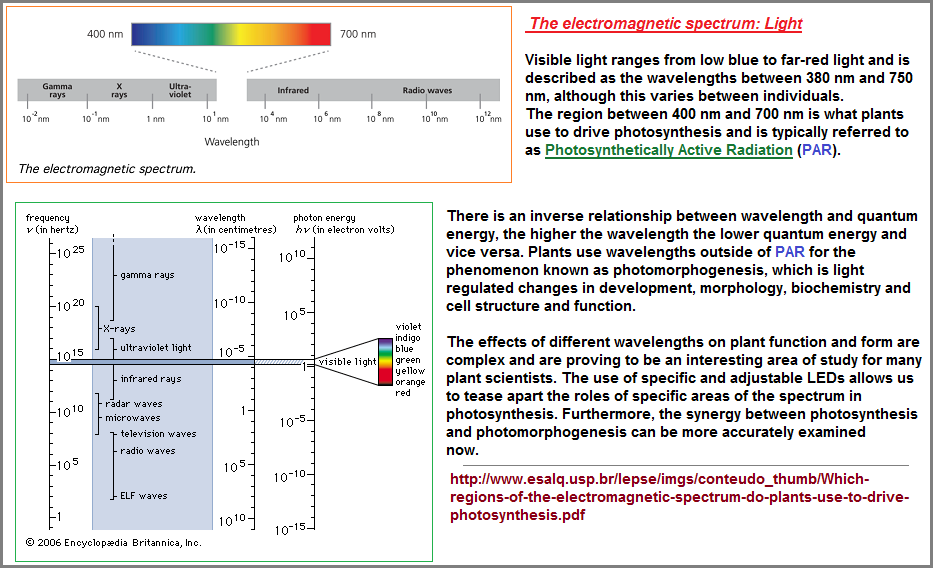
The "Triplet Code" is a remark which points to the usage of a Conservation, just as we see Nature engaging in when we notice examples such as a bundle of chemical elements totaling 118, as well as the triplet code, or the octet code, etc... In other words, even though we have a word such as "infinity" which is a modern day substitute for the primitive's "Many" (such as in the early counting sequences of 1-Many, 1,2-Many, 1,2,3-Many); we do not readily make use of it, but instead use other words such as Universe, Eternity, Forever, Immortality, etc., as substitutes for it. Likewise, though Nature has access (or so we might think) to Infinity and the entire Universe, it instead uses a conservative approach in the design of life such as relying on a mere 20 amino acids and a mere triplet code. Nature apparently does not like complexity as a basic model, but as an emergent one brought about by a runaway train of multiplication. Needless to say, such conservations should be addressed in our attempted analysis of the Triplet Code's Origination. The conditions under which it took place may need to be addressed first, since having a chemical recipe is not enough if the cook does not have the necessary cooking tools. In this sense... while some may attempt to modernize an old tale, some measure of the old theme is kept as it was. For example, the Giant in the story of Jack and the Beanstalk may be presented in new versions as a kind and considerate individual instead of a monstrous brute, while the three items of the old lore remain. In this case there is still the golden goose, the singing harp and bags of coins. Likewise, it is unlikely the stories of the 3 pigs, 3 bears and 3 kittens who lost their mittens would be replaced by one, two or more than three in most circumstances.
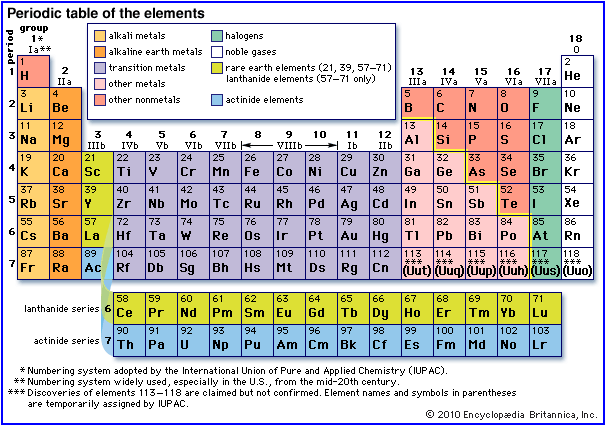
If there is an ongoing developmental sequence in which Evolution maps out a course symbolically defined as a 1-2-3 maturational development sequence, then the presence of the following patterns fit well into this consideration:
- Single-stranded RNA followed by a Double-stranded DNA... yet the idea of a triple-stranded model is conceptualized.
- A single amino acid defines the identity of RNA and DNA, much in the manner as two siblings having separate singular first names, while the third (surname) is the same. Hence, the three identical amino acids represent a type of surname. Conspicuously absent is a second or middle name. Let us also note that placing the surname last admits to the naming convention seen amongst the Chinese, and not the Western peoples.
- Amino acids are typically paired.
- Double chromosomes is the rule, triple chromosomes represents a troublesome trisomy in humans but a viability in grain crops.
- Cell division occurs as 1) a single cell that is doubled, 2) the doubled cell is then followed by multiplicity. This gives us a 1- 2- Many scenario, with the third division the beginning of multiplicity:
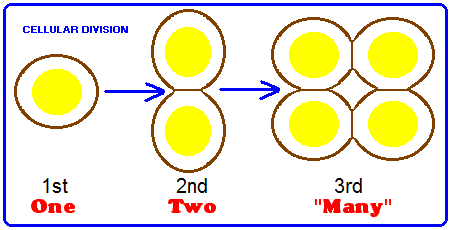
Whereas there is the idea that if you seek out a pattern you can find it, is it better to find it when you are seeking it out, or when you aren't expecting it? Does being surprised enhance the value of a pattern and make it more appealing as a presumed truth, whereas in seeking it out and finding it as an expectation, that which is found is less valuable? For example, if you are interested in a given type of vehicle you may begin to notice them as you drive along different pathways in your daily re-runs and exclaim to yourself that there is a lot of them, yet having not sought them out you were oblivious to their now obvious presence. And yet, upon exclaiming such a finding... an observation to someone else who has not noticed it, they may want to react negatively to it by making some remark of presumed logic which is meant to diminish an actual insightful truth about a given pattern, and thus attempt to establish their view as being the more important, because an assumed explanation of an actual recurrence that they may not have made but would liked to have been the 1st person to describe, supposedly trumps the other statement. And yet, the ability of the first person to make such an observation as they pointed out, is a particularly advantageous perspicuity that can be applied elsewhere and continue to make initial observations of that which others overlook. However, in many situations, the person whose observations are diminished, may hold the other person's perspective in a higher regard than their own, but should not do so.
A chemistry book or cook book, much like a witch's book of spells... is of little value if their instructions are not conducted in the appropriate setting. Indeed, many a professional or would-be expert even don some garment as if there is a dress code requirement for effecting a better... or real... or true outcome. There may also be a ritual alignment of tools and placement of ingredients as well as "mood" music to add as a condiment called ambiance. And if we break down these items into basic formulas, we find ourselves in the fields of chemistry, mathematics and physics. For example, we will begin to think in terms of time and quantity as well as waves... if not vibrations. Hence, how much time did it take the macromolecules to cook, how much of what kind was available, if a pressure cooker was used with a given gaseous content. No less, the waves of ultraviolet radiation, the vibrations to be felt and heard at the distant past on Earth; such as was there a louder "white noise" in the reduced oxygen atmosphere? No less, what was the color of the sky and did it have an affect on the early macromolecules?
So too is one disposition altered depending on whether they are confronted by a training manual on wrestling, boxing, or martial arts or even the do-it-yourself pamphlet of instructions for assembling a piece of furniture, bicycle or scaled-model replica of a ship. If you are the occasional backyard barbecue chef and I tell you that you will be cooking in a laboratory, you might decide not to do any cooking. On the other hand, if you're a virologist and I said you would be doing your "cooking" in someone's backyard with the neighbors and their kids (along with their pets), you too might be reluctant to do any "meal" preparation. The point being that as a researcher you may have created an image of what is the proper setting for you to engage in your activities, even if they are not appropriate for achieving the desired outcome. In fact, you may have it in your mind that the correct setting involves specialized tools and equipment, along with a clean environment and yourself in a spic-and-span white uniform with a certain, habitually used deodorant on. And if someone were to suggest the setting be otherwise, you might offer any number or rational explanations. One of which is that you are subjecting your materials to a presumed early Earth setting and your cleanliness is an attempt not to introduce uncontrolled ingredients into the mix. And yet, you still maintain using the same setting, albeit with different ingredients. This of course doesn't allow you to see your efforts of trying to plant different seeds in different mediums like cement, lime, stucco, or pile of salt that was used to melt snow on a highway with.
Whereas different cooks have their own versions of what makes the proper environment for carrying out research, all of us take for granted that the ideas of using basic ingredients in certain proportions is correct. Yet, are we chasing after a golden chalice or golden fleece that doesn't actually exist... yet we think it does because others have told us it is correct?
The point I am getting at is whether or not we can be confident that a "Triplet" code is even true, or is it the case that the mindset of many humans, least of all Crick and Watson; is inclined to see and use a "three" theme and thus that is what we have, particularly when it has been told that instead of a double-strand the idea of a triple strand was proposed by Linus Pauling and Robert Corey:
... Linus Pauling, then the world's leading physical chemist, had recently discovered the single-stranded alpha helix, the structure found in many proteins, prompting biologists to think of helical forms. Moreover, he had pioneered the method of model building in chemistry by which Watson and Crick were to uncover the structure of DNA. Indeed, Crick and Watson feared that they would be upstaged by Pauling, who proposed his own model of DNA in February 1953, although his three-stranded helical structure quickly proved erroneous. (Discovery of the Double Helix)
While serving as a visiting professor at the University of Oxford in 1948, Pauling returned to a problem that had intrigued him in the late 1930s—the three-dimensional structure of proteins. By folding a paper on which he had drawn a chain of linked amino acids, he discovered a cylindrical coil-like configuration, later called the alpha helix. The most significant aspect of Pauling's structure was its determination of the number of amino acids per turn of the helix. During this same period he became interested in deoxyribonucleic acid (DNA), and early in 1953 he and protein crystallographer Robert Corey published their version of DNA's structure, three strands twisted around each other in rope-like fashion. Shortly thereafter James Watson and Francis Crick published DNA's correct structure, a double helix, (based on Rosalind Franklin's X-ray pictures of DNA which Pauling did not see). ("Pauling, Linus." Encyclopædia Britannica, 2013.)
In addition, as a supplement to the idea that (at least) the American culture appears to be proportionately oriented towards the usage of a "three" model of conceptualization, permit be to reference an old Cultural Anthropology survey entitled The Number Three in the American Culture by Professor Alan Dundez, which was placed in a book (entitled "Every Man His Way") containing a collection of different cultural observations by multiple authors. Indeed, one must wonder why the use of a "three" formula is so persistent when in centuries past there was an inclination to reference the "7" since it was viewed as a sacred number due to the observation of there being seven stars in the Big Dipper and Pleiades (called the seven sisters), which was thought to make a statement about some preference for this number by the gods in the starry heaven.
Because the concept of "thinking in threes" can be supported by the numerous examples one might provide, let me say that the "three" value is 'point-front', so-to-speak in terms of thought processing for many people, even if they aren't aware that they use the value more so than others. Thus, taking some time to address the incidence for the usage of a "three" theme is not unreasonable since it may indicate a culturally-induced bias or actually is more important than suggested by those who prefer to discriminate against any suggestion that "there is something to it" but no one has yet come to provide any reasonable (and verifiable) explanation and not merely use the argument that it is their belief. If the usage of a Triplet Code is based on some notion of a "belief" being pursued by "Mother Nature", humanity may or may not be in trouble since she has a shelf life and may be inclined towards the use of Old Wives tales she has impressed upon the psyche of humanity as some measure by which a life-promising equilibrium can be serviced... metaphorically speaking.
Whereas in many cases the particular "three code" may be a cultural theme, in other instances a particular "three" rule may be commonly accepted the world over, such as for example the 3 laws of Motion by Sir Isaac Newton, the 3 laws of Planetary motion by Johannes Kepler and the rule of using a 3-colored stop light for intersections. While none of them is called a triplet code, that's exactly what they are. It is particularly naive, if not discriminatory and egotistical to reserve the phrase "Triplet code" in a singular fashion to a context of Biology. This is as silly as excluding the words Art, Music and Poetry from Mathematics, Medicine and Philosophy. There is no way of stating that the underlying genetic model of a triplet code does not have some influence on the development of multiple cognitive-based three-patterned organizational themes, particularly when the triple code has been biologically followed by the development of three germ layers and this has been followed by a tripartite brain development... not to mention an anatomy teeming with three-patterned examples occurring on the 3rd planet from a life-energizing source of light and heat with a widdershins (levorotary) directional spin. However, unless you see for yourself how many "three" patterns actually occur with anatomy, you may not believe it. Hence, to the right is a condensed image of a list thereof.
The information on the chart to the right is culled from Dr. McNulty's "Threes in Human Anatomy". For those wanting the chart, I provide this link to the Anatomy chart.pdf

It is particularly astonishing to find that out of the presently assumed 8 billion people on the planet that no one has put together a simple timeline reference of multiple "threes" themes that no doubt millions of people have encountered. For example:
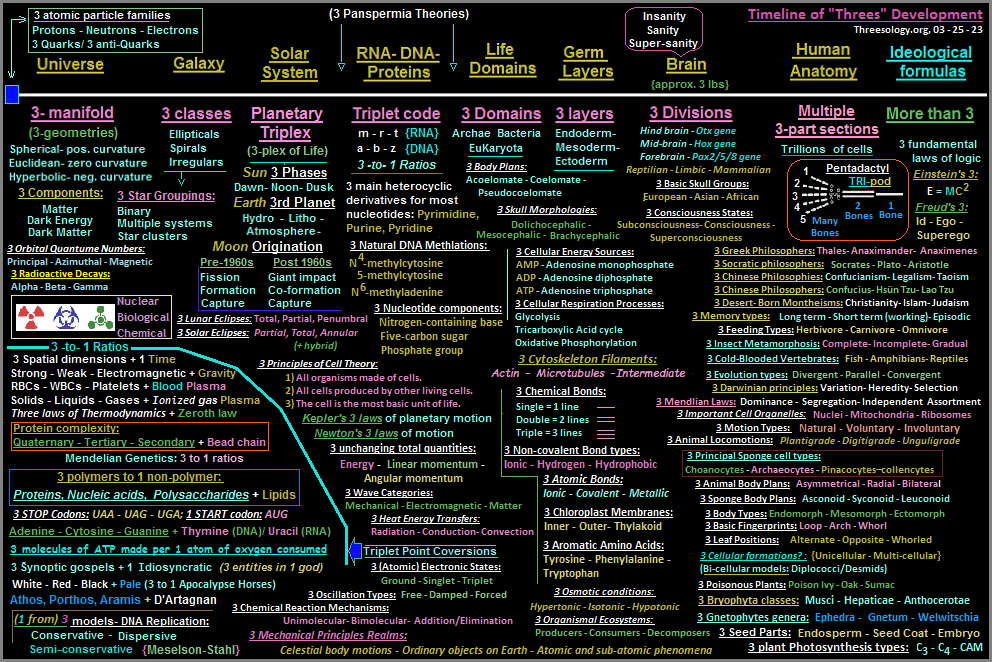
Date of Origination: Monday, 6th March 2023... 4:54 AM
Initial Posting: Monday, 27th March 2023... 11:08 AM